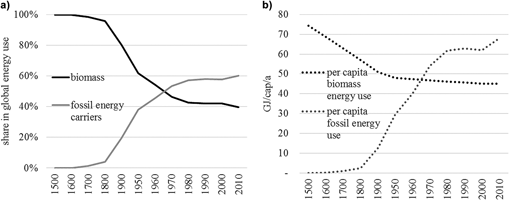Crossref Citations
This article has been cited by the following publications. This list is generated based on data provided by
Crossref.
Yap, Nonita T.
2016.
Unconventional shale gas development: challenges for environmental policy and EA practice.
Impact Assessment and Project Appraisal,
Vol. 34,
Issue. 2,
p.
97.
Ford, Patrick
Santos, Eduardo
Ferrão, Paulo
Margarido, Fernanda
Van Vliet, Krystyn J.
and
Olivetti, Elsa
2016.
REWAS 2016.
p.
289.
Dai, Pei
Mo, Zhao-Hua
Xu, Ri-Wei
Zhang, Shu
Lin, Xiao
Lin, Wen-Feng
and
Wu, Yi-Xian
2016.
Development of a cross-linked quaternized poly(styrene-b-isobutylene-b-styrene)/graphene oxide composite anion exchange membrane for direct alkaline methanol fuel cell application.
RSC Advances,
Vol. 6,
Issue. 57,
p.
52122.
Kramm, Johanna
Pichler, Melanie
Schaffartzik, Anke
and
Zimmermann, Martin
2017.
Societal Relations to Nature in Times of Crisis—Social Ecology’s Contributions to Interdisciplinary Sustainability Studies.
Sustainability,
Vol. 9,
Issue. 7,
p.
1042.
Reguera, L.
and
Reguera, E.
2017.
Handbook of Solid State Chemistry.
p.
249.
Pichler, Melanie
Schaffartzik, Anke
Haberl, Helmut
and
Görg, Christoph
2017.
Drivers of society-nature relations in the Anthropocene and their implications for sustainability transformations.
Current Opinion in Environmental Sustainability,
Vol. 26-27,
Issue. ,
p.
32.
Czaja, P.
Chulist, R.
Tokarski, T.
Czeppe, T.
Chumlyakov, Y. I.
and
Cesari, E.
2018.
Superelastic behavior of a metamagnetic Ni–Mn–Sn single crystal.
Journal of Materials Science,
Vol. 53,
Issue. 14,
p.
10383.
Lyons, James R.
Gharib-Nezhad, Ehsan
and
Ayres, Thomas R.
2018.
A light carbon isotope composition for the Sun.
Nature Communications,
Vol. 9,
Issue. 1,
Banik, Senjuti
Mahajan, Ankita
Ray, Apurba
Majumdar, Dipanwita
Das, Sachindranath
and
Kumar Bhattacharya, Swapan
2019.
Temperature control synthesis of platinum nanoparticle-decorated reduced graphene oxide of different functionalities for anode-catalytic oxidation of methanol.
FlatChem,
Vol. 16,
Issue. ,
p.
100111.
Hartley, Tilman
and
Xin, Baogui
2019.
The continuing evolution of ownership.
PLOS ONE,
Vol. 14,
Issue. 2,
p.
e0211871.
Wu, Zhanglan
Schaffartzik, Anke
Shao, Qinglong
Wang, Dong
Li, Guicai
Su, Yantao
and
Rao, Lei
2019.
Does economic recession reduce material use? Empirical evidence based on 157 economies worldwide.
Journal of Cleaner Production,
Vol. 214,
Issue. ,
p.
823.
Abdel-Karim, R.
Reda, Y.
Zohdy, K.M.
Abdelfatah, A.
and
El-Raghy, S.
2019.
Electrochemical Performance of Porous Ni-Cu Anodes for Direct Methanol Fuel Cells.
International Journal of Electrochemical Science,
Vol. 14,
Issue. 3,
p.
3035.
Pichler, Melanie
Brand, Ulrich
and
Görg, Christoph
2020.
The double materiality of democracy in capitalist societies: challenges for social-ecological transformations.
Environmental Politics,
Vol. 29,
Issue. 2,
p.
193.
Tran, Thao Quynh Ngan
Park, Bang Ju
Yun, Woo Hyun
Duong, Tien Nhac
and
Yoon, Hyon Hee
2020.
Metal–organic framework–derived Ni@C and NiO@C as anode catalysts for urea fuel cells.
Scientific Reports,
Vol. 10,
Issue. 1,
Schaffartzik, Anke
Pichler, Melanie
Pineault, Eric
Wiedenhofer, Dominik
Gross, Robert
and
Haberl, Helmut
2021.
The transformation of provisioning systems from an integrated perspective of social metabolism and political economy: a conceptual framework.
Sustainability Science,
Vol. 16,
Issue. 5,
p.
1405.
Wang, Ranran
Assenova, Valentina A.
and
Hertwich, Edgar G.
2021.
Energy system decarbonization and productivity gains reduced the coupling of CO2 emissions and economic growth in 73 countries between 1970 and 2016.
One Earth,
Vol. 4,
Issue. 11,
p.
1614.
Papież, Monika
Śmiech, Sławomir
Frodyma, Katarzyna
and
Borowiec, Justyna
2022.
Decoupling is not enough - Evidence from fossil fuel use in over 130 countries.
Journal of Cleaner Production,
Vol. 379,
Issue. ,
p.
134856.
Beaucaire, Krystof
Saey-Volckrick, Joëlle
and
Tremblay-Pepin, Simon
2023.
Integration of approaches to social metabolism into democratic economic planning models.
Studies in Political Economy,
Vol. 104,
Issue. 2,
p.
73.
Malico, Isabel
2024.
Forest Bioenergy.
p.
171.





